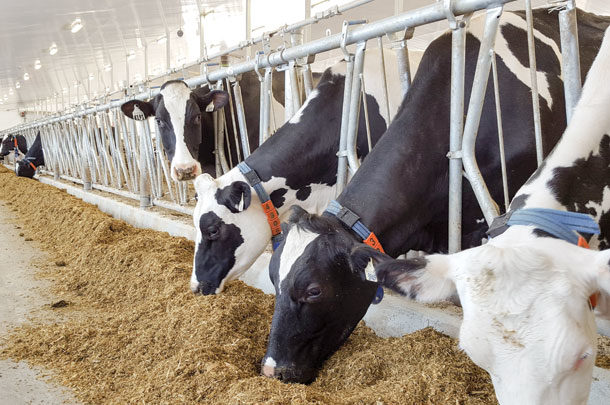However, just because we put great feed in front of cows, does not mean cows will always get the most value from that feed. In many cases, cows do not consume enough of the feed. Also, from that feed and resultant digestion of it, not all the available nutrients consumed may be fully utilized by the cow. These problems may be directly related to the way cows eat and ruminate their feed.
Eating behaviour
The ways cows eat directly relates to how much they consume, as well as to their rumen health and digestion. How much a dairy cow eats is simply a function of her eating behaviour; that is the total intake (kilograms per day) of a cow is the result of the number of meals consumed daily (meals per day) and the size of those meals (kilograms per meal).
Similarly, intake can be expressed as a function of the total time a cow spends feeding per day (minutes per day) multiplied by the rate (kilograms of dry matter per minute) at which she consumes that feed. Therefore, if a cow wants to consume more feed, she needs to adjust some aspect of her eating behaviour.
In recent research, we have shown that greater feed intake, as well as milk production, are more consistently associated with cows spending more time at the bunk, with more frequent, smaller meals (as opposed to eating larger, faster meals).
This type of eating pattern is not only good for production, but also for rumen health and efficiency. Maximizing time spent feeding at the bunk, in smaller meals, is also important for keeping the rumen stable – this may further translate into improved fibre digestibility and improved milk fat content.
The importance of time
The importance of devoting sufficient time to rumination also should not be overlooked. Dairy cows rely on rumination to digest their food. When cows ruminate, feed particles are broken down into smaller pieces; this not only allows rumen bugs (microbes) to do a better job at digesting that feed, but also helps assist in moving the material from the rumen once digested.
The faster digested feed is removed from the rumen – the more feed the cow can consume. Thus, allowing for cows to maximize their time devoted to rumination contributes to the ability of cows to maximize their feed intake. While cows ruminate, they also produce saliva, which contains bicarbonate, a substance that helps reduce the acidity levels in the rumen. Therefore, maximizing rumination further contributes to a more stable rumen environment, favourable to good feed digestibility.
Maximizing time
The question then arises, how do we make sure cows maximize their eating and rumination time?
It starts with a well-balanced diet, formulated to meet their production requirements, with adequate effective fibre to promote slower consumption and longer rumination times. Beyond that, we also need to ensure that cows are stimulated to access their feed throughout the day, as well as have the time and desire to ruminate their feed.
In a series of studies, we have shown that the most consistent and effective way to stimulate feeding activity is to deliver new feed, which creates much more of a feeding response than the time of day, milking or pushing up of feed.
Delivering feed more than one time a day helps promote those favourable eating patterns described above, resulting in improved digestion efficiency and greater milk fat content. Producers are, thus, encouraged to deliver fresh feed as often as feasible across the day.
The next most important thing, in between feed deliveries, is to ensure that cows always have access to feed that is in the bunk. Pushing up feed in the bunk frequently will ensure that, no matter when or why the cow is at the bunk, there is feed available for her.
If most of the cows come rushing to the bunk once the feed is pushed up, it means that cows have gone too long without feed available to them and need their feed pushed up more frequently. This type of behavioural response may also be an issue on farms that feed for very little, to no, refusals. If cows are without feed at the bunk for too long a period of time, they will, upon the next feed delivery, consume their feed too fast, in much too large of a meal.
Access to feed may also be influenced in group-housing situations by the level of competition for resources in the pen, such as feeding space. When we overcrowd pens of cows, such that not all cows can eat at one time, cows will change their consumption patterns, consuming larger, faster meals or altering their patterns of intake whereby they may forgo eating opportunities at time of the day when they are motivated to do so. Thus, our goal should be to provide enough bunk space so all cows can comfortably feed at the same time.
Time spent ruminating is largely dictated by the diet consumed, as well as the amount consumed; however, the factors which influence the daily activity patterns of cows have the potential to influence the amount of time devoted to rumination. Dairy cows typically ruminate in a diurnal pattern, with the longest period of rumination occurring when the animal is not active (eating or milking), but when at rest (lying down).
As such, most rumination activity occurs while resting at night, with other major bouts of rumination occurring during the middle of the day while resting between other periods of activity. It is not surprising, therefore, that any disruption to a cow’s normal rest time may result in a decrease in rumination time; this may then lead to reduced feed intake and production.
Maximizing rest time is then a key component to optimizing rumination. This is accomplished by providing stalls (tiestalls or freestalls) that are sufficiently sized to allow cows to lay down and stand up without hindrance, as well as that have a comfortable lying surface (i.e., deep bedding or sufficient bedding on top of mattresses). Rumination is also maximized by minimizing heat stress, as well as limiting social stressors found in group-housing situations (e.g., overcrowding and regrouping of cows).
In summary, feed consumption, digestion efficiency and production are optimized when cows have the ability to maximize their time spent eating and ruminating. This is accomplished by not only providing cows a well-balanced diet, but ensuring that cows always have feed in front of them, can access feed when they want to, are stimulated to access that feed throughout the day and have sufficient time and opportunity to rest. ![]()
Dr. Trevor DeVries presented this topic at the Symposium sur les bovins laitiers 2016 in Drummondville, Quebec. Visit www.craaq.qc.ca to watch the full conference video.
PHOTO: Just because you deliver a well-balanced ration doesn’t mean cows will get all of the nutrients they require. Understand their eating behaviour to help them consume what they need. Photo provided by Trevor DeVries.

-
Trevor DeVries
- Associate Professor
- University of Guelph
- Email Trevor DeVries










